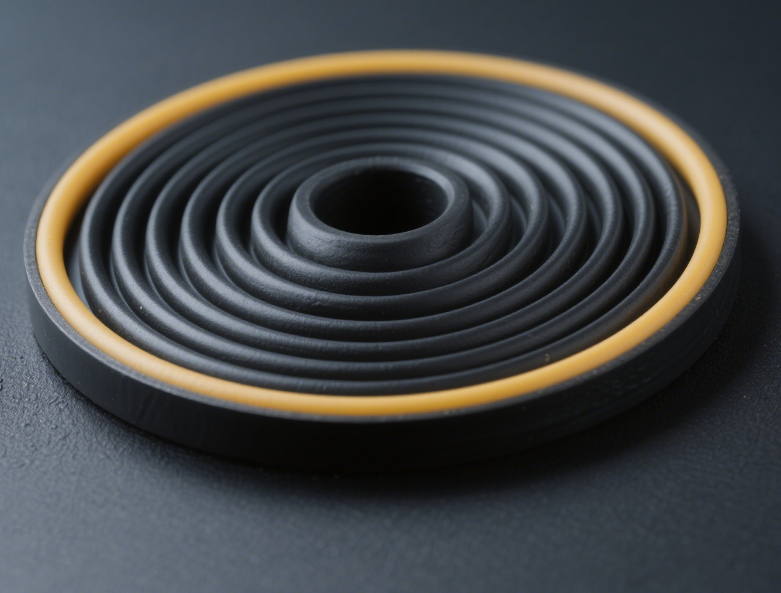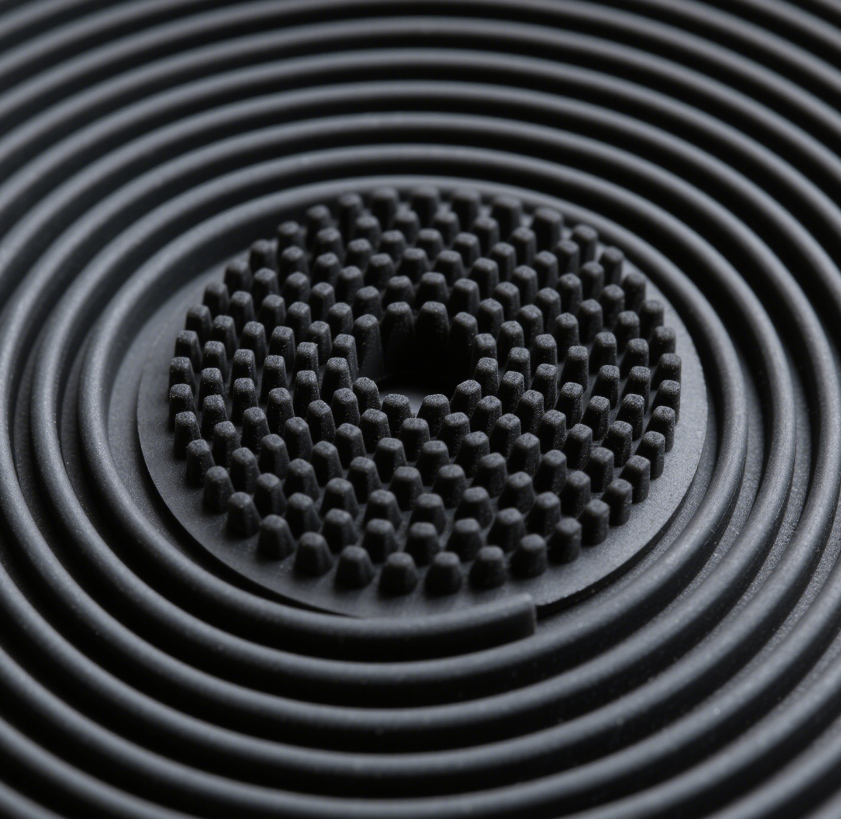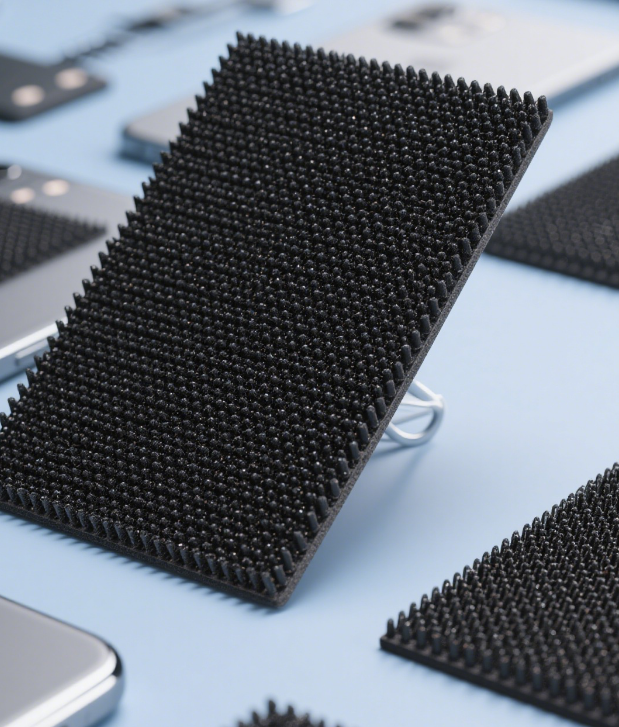Application of New-Type Wave-Absorbing Fillers in Silicone Rubber
2025/04/18
0
 I. Introduction
I. IntroductionWith the rapid development of high-frequency electronic technologies such as 5G communication and radar detection, the problems of electromagnetic interference and electromagnetic radiation have become increasingly prominent, and the demand for high-performance wave-absorbing materials is more urgent. Silicone rubber, with its excellent weather resistance, flexibility, and processing properties, has become an ideal matrix for wave-absorbing materials. As the core element determining the performance of wave-absorbing materials, traditional wave-absorbing fillers have certain limitations in terms of wave-absorbing efficiency and bandwidth. The emergence of new-type wave-absorbing fillers has opened up a new path for improving the wave-absorbing performance of silicone rubber. This article will conduct an in-depth discussion on the application of new-type wave-absorbing fillers in silicone rubber, analyze their action mechanisms, application effects, and the challenges they face.
II. Types and Action Mechanisms of New-Type Wave-Absorbing Fillers
(一) Two-Dimensional Nanomaterials
. Graphene and Its Derivatives: Graphene has excellent electrical properties and a large specific surface area. Adding graphene or graphene oxide to silicone rubber can dissipate electromagnetic energy through electronic polarization, conductivity loss, and interfacial polarization. The abundant functional groups on the surface of graphene oxide can enhance the interfacial bonding force with the silicone rubber matrix and reduce the agglomeration phenomenon. During the preparation process, reducing graphene oxide can further improve its electrical conductivity and optimize the wave-absorbing performance.
. MXene: MXene is a new type of two-dimensional transition metal carbide or nitride, with high electrical conductivity and unique surface properties. Functional groups such as -OH and -F on its surface make it have good compatibility with the silicone rubber matrix. After being dispersed in silicone rubber, it can form a conductive network and absorb electromagnetic energy through dielectric loss. At the same time, the sheet structure of MXene can extend the propagation path of electromagnetic waves inside the material and increase the absorption efficiency.
. Graphene and Its Derivatives: Graphene has excellent electrical properties and a large specific surface area. Adding graphene or graphene oxide to silicone rubber can dissipate electromagnetic energy through electronic polarization, conductivity loss, and interfacial polarization. The abundant functional groups on the surface of graphene oxide can enhance the interfacial bonding force with the silicone rubber matrix and reduce the agglomeration phenomenon. During the preparation process, reducing graphene oxide can further improve its electrical conductivity and optimize the wave-absorbing performance.
. MXene: MXene is a new type of two-dimensional transition metal carbide or nitride, with high electrical conductivity and unique surface properties. Functional groups such as -OH and -F on its surface make it have good compatibility with the silicone rubber matrix. After being dispersed in silicone rubber, it can form a conductive network and absorb electromagnetic energy through dielectric loss. At the same time, the sheet structure of MXene can extend the propagation path of electromagnetic waves inside the material and increase the absorption efficiency.
(二) Metal-Organic Frameworks (MOF) and Their Derivatives
. MOF Materials: MOF is a porous crystalline material formed by the self-assembly of metal ions or clusters and organic ligands, with a high specific surface area and adjustable pore structure. Adding MOF to silicone rubber, its unique pore structure can make electromagnetic waves reflect and scatter multiple times inside the pores, increasing energy loss. In addition, the polarization effect of the organic ligands in MOF also contributes to electromagnetic absorption.
. MOF Derived Materials: By subjecting MOF to treatments such as high-temperature carbonization and metal doping, derived materials with special structures and properties can be prepared, such as carbon-based materials and metal-carbon composite materials. These derived materials inherit the high specific surface area and unique structure of MOF, and at the same time have better electrical conductivity and magnetic properties, which can significantly improve the wave-absorbing performance in silicone rubber.
. MOF Materials: MOF is a porous crystalline material formed by the self-assembly of metal ions or clusters and organic ligands, with a high specific surface area and adjustable pore structure. Adding MOF to silicone rubber, its unique pore structure can make electromagnetic waves reflect and scatter multiple times inside the pores, increasing energy loss. In addition, the polarization effect of the organic ligands in MOF also contributes to electromagnetic absorption.
. MOF Derived Materials: By subjecting MOF to treatments such as high-temperature carbonization and metal doping, derived materials with special structures and properties can be prepared, such as carbon-based materials and metal-carbon composite materials. These derived materials inherit the high specific surface area and unique structure of MOF, and at the same time have better electrical conductivity and magnetic properties, which can significantly improve the wave-absorbing performance in silicone rubber.
(三) Nanocomposites
. Magnetic-Electrical Loss Composite Nanomaterials: Combining magnetic nanoparticles (such as ferrite and carbonyl iron) with electrical loss-type nanomaterials (such as carbon nanotubes and graphene) can broaden the wave-absorbing bandwidth by combining the synergistic effects of magnetic loss and electrical loss. For example, in the ferrite-carbon nanotube composite material in silicone rubber, ferrite provides magnetic loss, and carbon nanotubes form a conductive network to generate electrical loss. The two work together to improve the overall wave-absorbing performance.
. Core-Shell Structure Nanomaterials: Preparing nanomaterials with a core-shell structure, such as using a magnetic material as the core and a dielectric material as the shell, can adjust the electromagnetic parameters of the material. The core-shell structure can optimize the impedance matching of the material, making it easier for electromagnetic waves to enter the interior of the material and be absorbed. After being dispersed in silicone rubber, the core-shell structure nanomaterials can give full play to the advantages of each component and achieve efficient wave absorption.
. Magnetic-Electrical Loss Composite Nanomaterials: Combining magnetic nanoparticles (such as ferrite and carbonyl iron) with electrical loss-type nanomaterials (such as carbon nanotubes and graphene) can broaden the wave-absorbing bandwidth by combining the synergistic effects of magnetic loss and electrical loss. For example, in the ferrite-carbon nanotube composite material in silicone rubber, ferrite provides magnetic loss, and carbon nanotubes form a conductive network to generate electrical loss. The two work together to improve the overall wave-absorbing performance.
. Core-Shell Structure Nanomaterials: Preparing nanomaterials with a core-shell structure, such as using a magnetic material as the core and a dielectric material as the shell, can adjust the electromagnetic parameters of the material. The core-shell structure can optimize the impedance matching of the material, making it easier for electromagnetic waves to enter the interior of the material and be absorbed. After being dispersed in silicone rubber, the core-shell structure nanomaterials can give full play to the advantages of each component and achieve efficient wave absorption.
III. Application Effects of New-Type Wave-Absorbing Fillers in Silicone Rubber
(一) Improvement of Wave-Absorbing Performance
Numerous studies have shown that adding new-type wave-absorbing fillers can significantly improve the wave-absorbing performance of silicone rubber. For example, adding a small amount of graphene oxide (mass fraction 3%) to silicone rubber can reduce the reflection loss to -25dB in the X-band (8 – 12GHz), and the effective wave-absorbing bandwidth increases. The silicone rubber filled with MXene has a maximum reflection loss of -30dB in the Ku-band (12 – 18GHz), and its wave-absorbing performance far exceeds that of silicone rubber filled with traditional fillers. After the silicone rubber is filled with carbon-based materials derived from MOF, the bandwidth with a reflection loss less than -10dB in the C-band (4 – 8GHz) can reach 3GHz, showing excellent wave-absorbing effects.
Numerous studies have shown that adding new-type wave-absorbing fillers can significantly improve the wave-absorbing performance of silicone rubber. For example, adding a small amount of graphene oxide (mass fraction 3%) to silicone rubber can reduce the reflection loss to -25dB in the X-band (8 – 12GHz), and the effective wave-absorbing bandwidth increases. The silicone rubber filled with MXene has a maximum reflection loss of -30dB in the Ku-band (12 – 18GHz), and its wave-absorbing performance far exceeds that of silicone rubber filled with traditional fillers. After the silicone rubber is filled with carbon-based materials derived from MOF, the bandwidth with a reflection loss less than -10dB in the C-band (4 – 8GHz) can reach 3GHz, showing excellent wave-absorbing effects.
(二) Improvement of Mechanical Properties
The good compatibility between the new-type wave-absorbing fillers and the silicone rubber matrix enables them to improve the mechanical properties of the material while enhancing the wave-absorbing performance. Two-dimensional nanomaterials such as graphene and MXene, due to their high specific surface area and strong mechanical properties, can enhance the tensile strength and tear strength of silicone rubber. The core-shell structure nanomaterials are evenly dispersed in silicone rubber, which can effectively transfer stress and improve the overall mechanical properties of the material. For example, the tensile strength of silicone rubber added with 2% core-shell structure nanomaterials is increased by 20%, and the elongation at break is also increased.
The good compatibility between the new-type wave-absorbing fillers and the silicone rubber matrix enables them to improve the mechanical properties of the material while enhancing the wave-absorbing performance. Two-dimensional nanomaterials such as graphene and MXene, due to their high specific surface area and strong mechanical properties, can enhance the tensile strength and tear strength of silicone rubber. The core-shell structure nanomaterials are evenly dispersed in silicone rubber, which can effectively transfer stress and improve the overall mechanical properties of the material. For example, the tensile strength of silicone rubber added with 2% core-shell structure nanomaterials is increased by 20%, and the elongation at break is also increased.
(三) Expansion of Multifunctionality
Some new-type wave-absorbing fillers endow silicone rubber with more functions. For example, silicone rubber containing MXene, in addition to its wave-absorbing performance, also has good thermal conductivity and self-healing properties; silicone rubber filled with MOF can utilize the adsorption characteristics of MOF and has both wave-absorbing and harmful gas adsorption functions, expanding the application fields of the material.
Some new-type wave-absorbing fillers endow silicone rubber with more functions. For example, silicone rubber containing MXene, in addition to its wave-absorbing performance, also has good thermal conductivity and self-healing properties; silicone rubber filled with MOF can utilize the adsorption characteristics of MOF and has both wave-absorbing and harmful gas adsorption functions, expanding the application fields of the material.
IV. Challenges Faced by the Application of New-Type Wave-Absorbing Fillers
(一) Dispersion Problem
Most new-type wave-absorbing fillers have a high specific surface area and special structures, and they are prone to agglomeration in the silicone rubber matrix, affecting the performance of their wave-absorbing and mechanical properties. For example, there is a strong van der Waals force between graphene sheets, which is difficult to disperse uniformly during the mixing process, resulting in local performance differences. How to achieve uniform dispersion of new-type wave-absorbing fillers in silicone rubber is a key problem that needs to be solved.
Most new-type wave-absorbing fillers have a high specific surface area and special structures, and they are prone to agglomeration in the silicone rubber matrix, affecting the performance of their wave-absorbing and mechanical properties. For example, there is a strong van der Waals force between graphene sheets, which is difficult to disperse uniformly during the mixing process, resulting in local performance differences. How to achieve uniform dispersion of new-type wave-absorbing fillers in silicone rubber is a key problem that needs to be solved.
(二) Cost and Preparation Process
The preparation costs of some new-type wave-absorbing fillers such as MOF and MXene are relatively high, and the preparation processes are complex, which limits their large-scale application. At the same time, the process of compounding new-type wave-absorbing fillers with silicone rubber also needs to be further optimized to improve production efficiency and product quality.
The preparation costs of some new-type wave-absorbing fillers such as MOF and MXene are relatively high, and the preparation processes are complex, which limits their large-scale application. At the same time, the process of compounding new-type wave-absorbing fillers with silicone rubber also needs to be further optimized to improve production efficiency and product quality.
(三) Performance Regulation and Optimization
The electromagnetic parameters of new-type wave-absorbing fillers are complex. After compounding with silicone rubber, how to precisely regulate the wave-absorbing performance of the material to meet the requirements of different scenarios still requires in-depth research. In addition, how to balance the relationship between wave-absorbing performance and other performances (such as mechanical properties and processing properties) is also an urgent problem to be solved.
The electromagnetic parameters of new-type wave-absorbing fillers are complex. After compounding with silicone rubber, how to precisely regulate the wave-absorbing performance of the material to meet the requirements of different scenarios still requires in-depth research. In addition, how to balance the relationship between wave-absorbing performance and other performances (such as mechanical properties and processing properties) is also an urgent problem to be solved.
V. Conclusions and Prospects
The application of new-type wave-absorbing fillers in silicone rubber shows great potential, and it has significant effects in improving wave-absorbing performance, mechanical properties, and expanding multifunctionality. However, currently, it still faces challenges such as dispersion, cost, preparation process, and performance regulation. Future research can start from aspects such as developing efficient dispersion technologies, reducing preparation costs, optimizing the compounding process, and establishing accurate performance prediction models to further promote the application of new-type wave-absorbing fillers in silicone rubber, and promote the development of high-performance wave-absorbing materials to meet the growing demand for electromagnetic protection.
The application of new-type wave-absorbing fillers in silicone rubber shows great potential, and it has significant effects in improving wave-absorbing performance, mechanical properties, and expanding multifunctionality. However, currently, it still faces challenges such as dispersion, cost, preparation process, and performance regulation. Future research can start from aspects such as developing efficient dispersion technologies, reducing preparation costs, optimizing the compounding process, and establishing accurate performance prediction models to further promote the application of new-type wave-absorbing fillers in silicone rubber, and promote the development of high-performance wave-absorbing materials to meet the growing demand for electromagnetic protection.
The above content has sorted out the application situation of new-type wave-absorbing fillers in silicone rubber. If you have more needs for the application cases and research directions of certain types of fillers, you are welcome to let me know at any time.
















